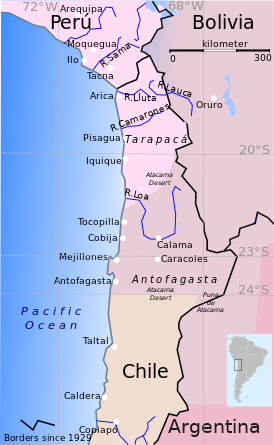
Back Salpeteroorlog Afrikaans حرب المحيط الهادئ (1879-1884) Arabic Guerra del Pacíficu AST Sakit okean müharibəsi Azerbaijani پاسیفیک ساواشی (۱۸۷۹-۱۸۸۴) AZB Тымыҡ океан һуғышы Bashkir Салетравая вайна Byelorussian Салетравая вайна BE-X-OLD Втора тихоокеанска война Bulgarian প্রশান্ত মহাসাগরের যুদ্ধ Bengali/Bangla
| War of the Pacific | |||||||||
|---|---|---|---|---|---|---|---|---|---|
 Map showing changes of territory caused by the War of the Pacific. Earlier maps from 1879 show different border lines between Bolivia and Peru and Bolivia and Argentina. | |||||||||
| |||||||||
| Belligerents | |||||||||
|
|
| ||||||||
| Commanders and leaders | |||||||||
|
Presidents of Bolivia H. Daza (1876–1879) P.J.D. de Guerra (1879) N. Campero (1879–1884) Presidents of Peru M.I. Prado (1876–1879) L. La Puerta (1879) N. de Piérola (1879–1881) F. García C. (1881) L. Montero F. (1881–1883) M. Iglesias (1882–1885) |
Presidents of Chile A. Pinto (1876–1881) D. Santa María (1881–1886) | ||||||||
| Strength | |||||||||
|
1879 (prewar) Peruvian Army: 1880 Peruvian Army:25,000–35,000 men (Army of Lima)[4] Peruvian Navy: 3 ironclads 7 wooden ships 2 torpedo boats[3] |
1879 (prewar) Chilean Army: 27,000 (Ante Lima) 8,000 (Occupation Force) 6,000 (Mainland)[6] Chilean Navy: 3 ironclads 8 wooden ships 10 torpedo boats[3] | ||||||||
| Casualties and losses | |||||||||
|
Killed and wounded: About 25,000[7] Captured: About 9,000[7] |
Killed: 2,791–2,825[8] Wounded: 7,193–7,347[8] | ||||||||
The War of the Pacific (Spanish: Guerra del Pacífico), also known by multiple other names, was a war between Chile and a Bolivian–Peruvian alliance from 1879 to 1884. Fought over Chilean claims on coastal Bolivian territory in the Atacama Desert, the war ended with victory for Chile, which gained a significant amount of resource-rich territory from Peru and Bolivia.
The direct cause of the war was a nitrate taxation dispute between Bolivia and Chile, with Peru being drawn in due to its secret alliance with Bolivia. Some historians have pointed to deeper origins of the war, such as the interest of Chile and Peru in the nitrate business, a long-standing rivalry between Chile and Peru for regional hegemony, as well as the political and economical disparities between the stability of Chile and the volatility of Peru and Bolivia.[A] In February 1878, Bolivia increased taxes on the Chilean mining company Compañía de Salitres y Ferrocarril de Antofagasta (CSFA), in violation of the Boundary Treaty of 1874 which established the border between both countries and prohibited tax increases for mining. Chile protested the violation of the treaty and requested international arbitration, but the Bolivian government, presided by Hilarión Daza, considered this an internal issue subject to the jurisdiction of the Bolivian courts. Chile insisted that the breach of the treaty would mean that the territorial borders denoted in it were no longer settled. Despite this, Hilarión Daza rescinded the license of the Chilean company, seized its assets and put it up for auction. On the day of the auction, 14 February 1879, Chile's armed forces occupied without resistance the Bolivian port city of Antofagasta, which was mostly inhabited by Chilean miners. War was declared between Bolivia and Chile on 1 March 1879, and between Chile and Peru on 5 April 1879.
Battles were fought on the Pacific Ocean, in the Atacama Desert, the Peruvian deserts, and the mountainous interior of Peru. For the first five months, the war played out in a naval campaign, as Chile struggled to establish a marine resupply corridor for its forces in the world's driest desert. Afterwards, Chile's land campaign overcame the Bolivian and Peruvian armies. Bolivia withdrew after the Battle of Tacna, on 26 May 1880, leaving allied Peru fighting alone for most of the war. Chilean forces occupied Peru's capital Lima in January 1881. Remnants and irregulars of the Peruvian army waged a guerrilla war but could not prevent war-weary Peruvian factions from reaching a peace deal with Chile involving territorial cessions.
Chile and Peru signed the Treaty of Ancón on 20 October 1883. Bolivia signed a truce with Chile in 1884. Chile acquired the Peruvian territory of Tarapacá, the disputed Bolivian department of Litoral (turning Bolivia into a landlocked country), and temporary control over the Peruvian provinces of Tacna and Arica. In 1904, Chile and Bolivia signed the Treaty of Peace and Friendship, which established definite boundaries. The 1929 Tacna–Arica compromise gave Arica to Chile and Tacna to Peru.
- ^ Sater 2007, p. 51 Table 2
- ^ Sater 2007, p. 45 Table 1
- ^ Sater 2007, p. 274
- ^ Sater 2007, p. 58 Table 3
- ^ Cite error: The named reference
sater2007_263was invoked but never defined (see the help page). - ^ a b Sater 2007, p. 349 Table 23.
- ^ a b Sater 2007, p. 348 Table 22. The statistics on battlefield deaths are inaccurate because they do not provide follow-up information on those who later died of their wounds.
- ^ St. John, Ronald Bruce; Schofield, Clive (1994). The Bolivia–Chile–Peru Dispute in the Atacama Desert. University of Durham, International Boundaries Research Unit. pp. 12–13. ISBN 1897643144.
Cite error: There are <ref group=upper-alpha> tags or {{efn-ua}} templates on this page, but the references will not show without a {{reflist|group=upper-alpha}} template or {{notelist-ua}} template (see the help page).